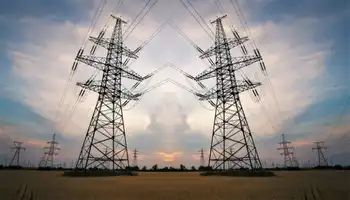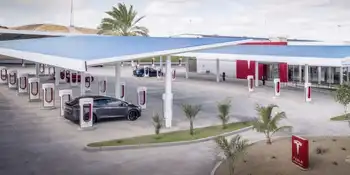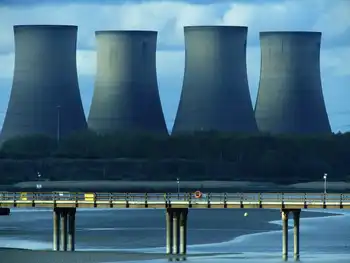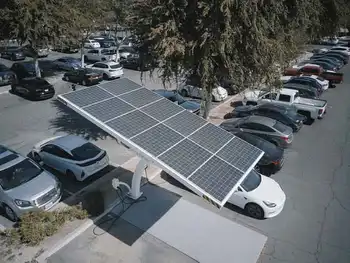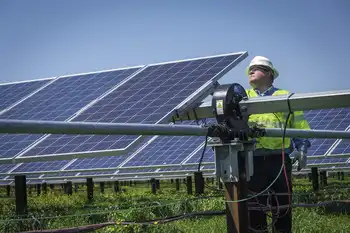Advancing the security of energy infrastructure
By Albuquerque Journal
NFPA 70b Training - Electrical Maintenance
Our customized live online or in‑person group training can be delivered to your staff at your location.

- Live Online
- 12 hours Instructor-led
- Group Training Available
But if you want to install ever-larger wind turbines, you need not only the manufacturing capacity to make blades and generators but also the massive cranes needed to install them, said Jose Zayas, a wind power researcher at Sandia National Laboratories.
And you need to get that crane to a construction site that is usually out in the middle of nowhere, Zayas pointed out.
The bigger the turbine blades get, the more problems you have getting them through freeway underpasses and down twisting country roads.
Such small problems illustrate the complex relationships at the core of the nation's energy system. The way those problems fit together, from little things like having enough cranes to vast issues like the adequacy of the electric grid or the vulnerability of the nation's oil-refining capacity, are at the heart of a growing Sandia National Laboratories initiative.
Organized under the label "energy security," the effort is aimed at leveraging expertise that grew out of nuclear work to help address the nation's 21st-century energy problems, said Les Shephard, the Sandia manager heading up the effort, during a recent tour of Sandia's energy research centers.
Consider the nation's electrical grid, said Terry Michalske, director of Energy, Resources and Systems Analysis at Sandia.
It is fragile, with complex interconnections that leave it so vulnerable that a single overgrown tree hitting the wrong power line in Ohio in 2003 set off a cascading system collapse that left 55 million people in the United States and Canada without electricity.
"It was not designed with our national security in mind," Michalske said. In fact, he acknowledged, the electric grid was not really "designed" at all, so much as assembled piece by piece by a host of different designers at different times, in different places, for different reasons.
Add to that a growing demand for electricity and a significant effort by U.S. leaders to shift away from traditional fossil fuels like coal to renewable power from solar and wind, along with a push to reduce U.S. reliance on imported oil, and you have a complex set of challenges, Michalske said.
"It's an enormous challenge for us," he said.
Sandia works on a wide range of specific technologies likely to play an increasing role in the nation's energy future, from solar power and light bulbs to the next generation of batteries being developed for plug-in cars.
During a tour, officials showed off new solar power machines being developed with a California company and discussed a next-generation small nuclear-power reactor under development.
They also featured new research aimed at using heat from sunlight to fuel a chemical reaction that literally makes gasoline out of air and water.
At the core of it all is Sandia's real strength, Michalske and others explained: "systems analysis." The field involves understanding how complex systems fit together, and how changes in one part can have sometimes unexpected consequences elsewhere.
Sandia's specialty in systems analysis grew out of its work as a nuclear weapon design center. While Los Alamos and Lawrence Livermore are responsible for the nuclear explosive package at a warhead's heart, Sandia does everything else — the electronics that set off the weapon, the locks and circuits that prevent unauthorized use, along with the security systems used to protect the weapons from theft.
That systems approach has become central to Sandia's energy work, Michalske said.
"It's not just the individual technologies," he said. "It's how you fit them together."
Consider the example of making ethanol fuel from corn to replace a portion of the nation's gasoline supply.
Embraced enthusiastically by the U.S. government, with strong support from the nation's farm lobby, it has made a major contribution to the nation's vehicle fuel supply, which might seem like a good thing.
But it has come with the sort of consequences that systems analysis might have helped prevent — rising food costs as land is shifted from food production to fuel production, for example, and increased water pollution in the Midwest as a result of the massive amounts of fertilizer dumped on corn fields.
The problems that grew out of corn ethanol-fuel manufacturing are "the poster child" for the importance of looking at the full system as we make energy decisions, Michalske said.
Transportation is one area where energy supply and national security are closely related, said Justine Johannes, who heads up the Sandia research group working on the issue.
We currently use about 20 million barrels of oil a day, two-thirds of which is imported, she noted. And 70 percent of that oil is used for transportation fuel, with no good alternatives available, according to Johannes.
An interruption in global supplies could cause a huge disruption to the economy, she said.
One technology solution, favored by many and being pushed by the federal government, is the introduction of plug-in hybrid cars that use a battery pack to power around-town driving.
But like all good systems problems, the technology introduces a whole host of issues, from new and different demands being placed on the power grid to questions of battery safety.
"You're going to be plugging those batteries in, in your garage," Johannes said, "and they'd better be safe."
The use of biofuels from ethanol faces a similarly difficult system problem, explained Ron Pate, a Sandia scientists who is studying ways of turning algae into liquid fuels.
It is not enough to simply come up with a great fuel that you can make out of wood chips or switchgrass or some easy-to-grow plant. You have to have something that can be, in his words, "drop-in equivalent" for fossil fuels now in use. Otherwise, you not only need to change your fuel sources but also all the pipelines and tanks used to distribute it, along with the engines that burn it.
"It's an infrastructure buildup issue," Pate said.
The work Pate and others is central to Sandia's national security mission, Shephard said: "We believe energy security is one of the most pressing national security challenges we face as a nation in the coming century."






